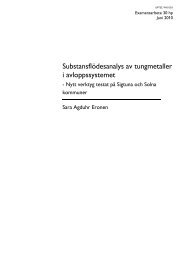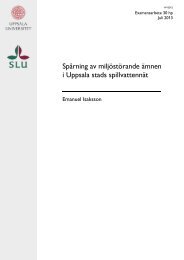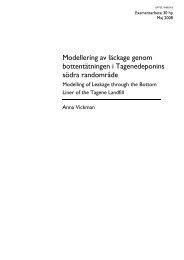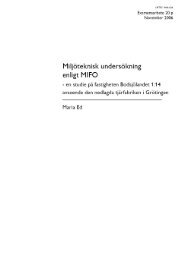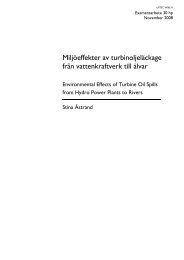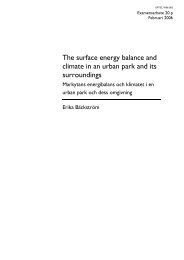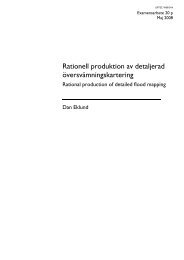Nutrient Transport Modelling in the Daugava River Basin - DiVA Portal
Nutrient Transport Modelling in the Daugava River Basin - DiVA Portal
Nutrient Transport Modelling in the Daugava River Basin - DiVA Portal
You also want an ePaper? Increase the reach of your titles
YUMPU automatically turns print PDFs into web optimized ePapers that Google loves.
Figure 1. The hydrological part of <strong>the</strong> GWLF model.3. MATERIALS AND METHODS3.1 SITE DESCRIPTION – THE DAUGAVA RIVER BASIN3.1.1 Geography and hydrographyThe <strong>Daugava</strong> <strong>River</strong> is <strong>the</strong> third largest river <strong>in</strong> <strong>the</strong> Baltic Sea bas<strong>in</strong> (Lund<strong>in</strong>, 2000). Theriver beg<strong>in</strong>s <strong>in</strong> <strong>the</strong> western part of Russia and flows through Belarus and Latvia where itenters <strong>the</strong> Baltic Sea <strong>in</strong> <strong>the</strong> Gulf of Riga (figure 2). The total length of <strong>the</strong> river is 1 005km (Klav<strong>in</strong>s et al., 2002). The river bas<strong>in</strong> has a small difference of elevation with<strong>in</strong> <strong>the</strong>bas<strong>in</strong>. Only a few hills are higher than 250 m above sea level (Ziverts, 1999). Thecatchment area is 85 900 km 2 (Hannerz and Destouni, 2005) and it is thus by def<strong>in</strong>itiona large river bas<strong>in</strong> (Klav<strong>in</strong>s et al., 2002). 32 % of <strong>the</strong> area belongs to Russia, 39 % toBelarus and 27 % to Latvia. The rema<strong>in</strong><strong>in</strong>g 2 % of <strong>the</strong> bas<strong>in</strong> belong to Estonia andLithuania (Hannerz and Destouni, 2005).4



